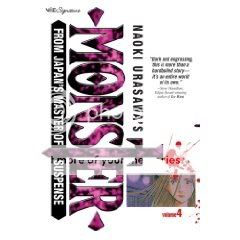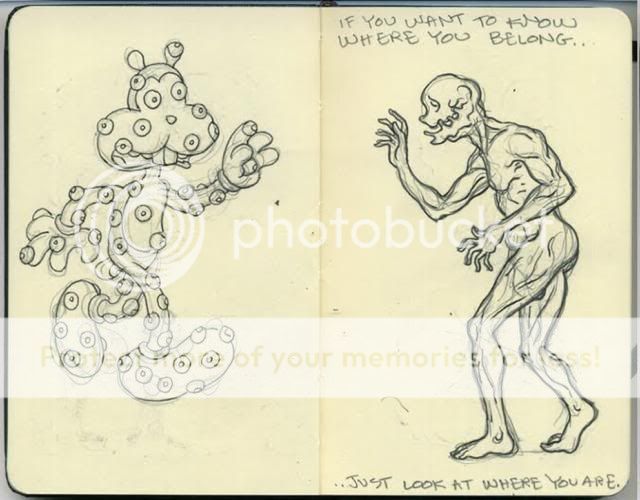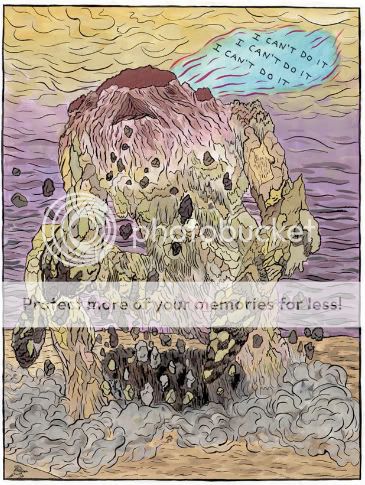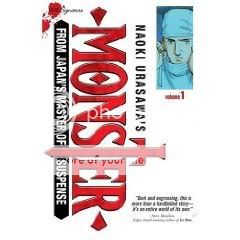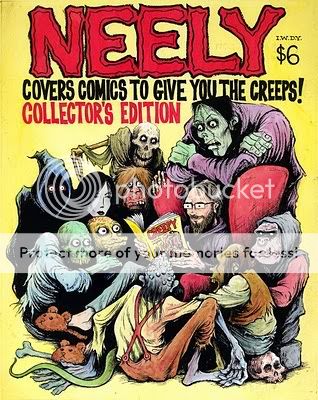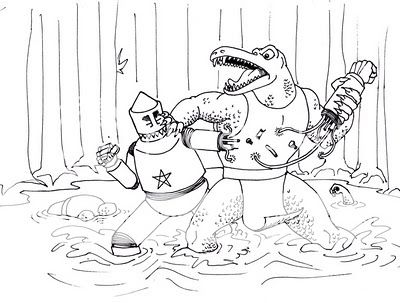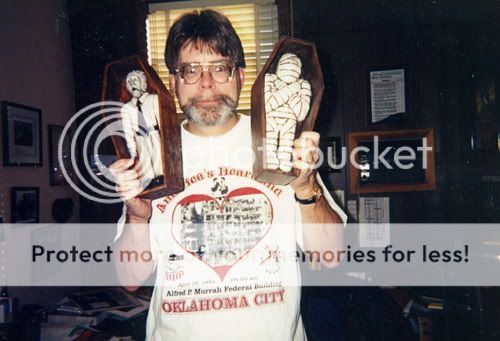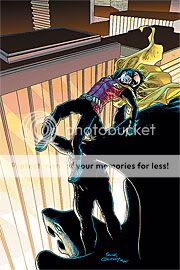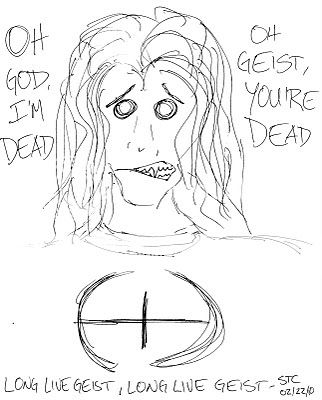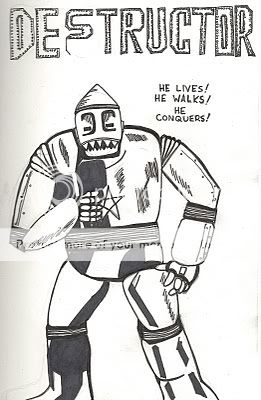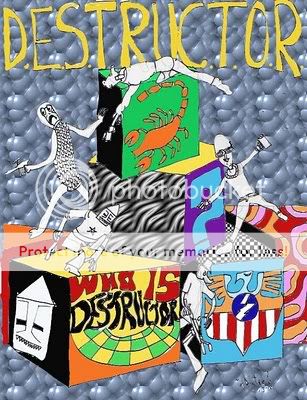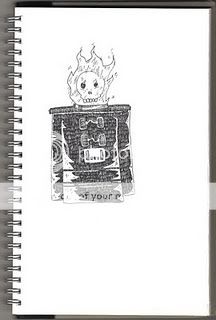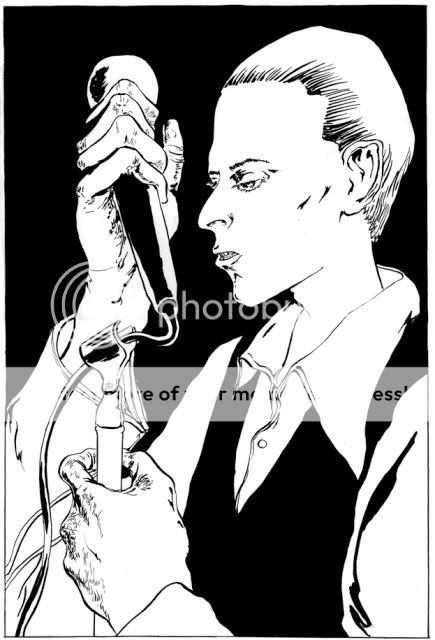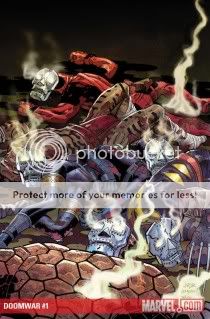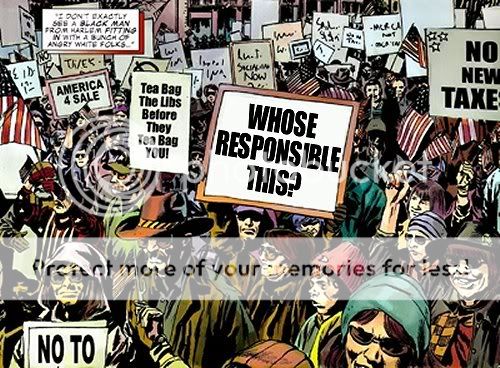SPOILER WARNING
Down in the bustling comment thread for this week’s episode, my brother Ryan carpet-bombed me with Lost knowledge bombs. Rather than respond to his lengthy comments downblog, I thought I’d pull them out and make a post of it. Ryan’s thoughts are in italics, mine are in roman.
This episode was amazing. Ben’s eulogy for Locke pretty much brought a tear to my eye. Also really enjoyed Sawyer calling out fake Locke even in a drunken stupor.
Two great, revealing character moments.
MIB’s tossing of the white rock into the ocean and describing it as an “inside joke,” was quite interesting as well. I guess you can draw a lot from that one action. The white rock could just symbolize Jacob in a literal sense. It could mean that with Jacob gone, the balance of power on the Island has swung back to fake Locke (and as we have been led to believe thus far, evil). Probably signifies both.
Right. The former idea is the “inside joke” aspect and the latter is the metaphorical aspect.
In reference to the creepy little boy, my best guess is that it is a young Jacob. I say this for a few reasons. First, I believe the first time MIB sees the little boy, the young boy has blood stained clothes. Jacob was stabbed to death brutally. The little kid had his hands out and, from my view, seemed to be bloodied. This is a lot like how Jacob looked when he was murdered.
Interesting. I need to check that out.
Secondly, in their next encounter, the little boy warns MIB (or fake Locke or Smokey or Esau) that he cannot kill Sawyer according to these darn “rules” that we always hear about. If this kid was Aaron or Claire (which I don’t think at all) , how do those two characters no the rules that only seem to be privy to MIB and Jacob??? Whidmore and Ben also speak of rules obviously but who knows if they are referring to the same things as Jacob and MIB.
I hadn’t thought of that line referring to Sawyer. Hmm! I thought of it as referring to Jacob, the implication of “you can’t kill him” being “he’s not really dead.” But it seems to work for Sawyer as well, if as you say the MIB is not able to kill candidates.
Also, Claire is currently on the Island in the same time frame. She just shot the Others that were going to kill Jin. Why would she then show up as a little child in clothing that we have never seen her in? In addition, the leader of the “temple” Others has mentioned to Jack that Claire has been claimed much like Sayid. If that is the case, it seems logical that MIB is the person or entity doing the claiming, no? If Claire has been claimed since the time she disappeared and left Aaron, don’t you feel that she is already under the influence of MIB? The real Locke was basically led to his ultimate demise while following the advice of Christian Sheppard. If dead people or dead bodies are claimed and used by MIB, I think it is reasonable to conclude that MIB somehow knew enough to orchestrate Locke’s leaving the Island only to ultimately be killed by Ben and brought back to the Island so that “a candidate” (Locke and his image) could infiltrate Jacob’s lair with Ben and persuade Ben to end Jacob’s reign on the Island.
1) I wonder if MIB has his own equivalent of recruiting “candidates” like Jacob does. Obviously Ilyana speaks of the MIB Locke “recruiting” Sawyer, but what about before that? Is Widmore working for MIB the way Ben is working for Jacob? Or are the dead entities the way that the MIB protects his legacy?
2) That theory about needing a candidate to ice Jacob is pretty tight.
If Claire was claimed, did she physically die somehow on the Island after leaving Aaron? Maybe she actually died when the house was blown up and somehow came back to life only to carry Aaron so far and leave him to the other Oceanic crew we know so well and then went off with Smokey and Christian Sheppard.
I remember people saying something along these lines at the time.
I think that Sawyer could see the young boy (maybe Jacob) because he is a candidate.
If that’s the case, then are we to infer that Jin couldn’t see the Ghost Jacob who visited Hurley because it’s Sun, not he, who is the “Kwon” candidate? Or is that a separate issue because that’s a straight-up ghost and we’ve established that the dead only talk to Hurley? (Or have their thoughts read by Miles.)
Also, it seems like we can believe MIB when he says that Jacob wrote those names on the cave ceiling because of the flashbacks linking Jacob to the names on the cave walls.
Right.
However, I only remember ever seeing Jacob on the beach or in the foot statue monument. Why would Jacob be living in a very shady cave on the side of a cliff that can only be reached by braving the rope ladders of death? Could it be possible that the names were not written by Jacob at all but by MIB?
I thought the same thing when we first entered the cave–that this is where the MIB lived, and that’s why, in the flashback where we first meet the real him and Jacob as they watch the Black Rock approach the Island, it’s said that it’s been a long time since they last saw each other. But I do feel like the show didn’t give us any cues that MIB Locke was lying about the basics of his story, even if I’m sure some of the details or spin are lies.
Perhaps through his activities as the Smoke monster, he knows about all the candidates and is systematically “claiming” or destroying them? Just a thought, it could easily be that he was telling the truth but you never know.
I would guess his unspoken goal is to kill the rest of the candidates to ensure that Jacob’s legacy would die with him. Why else recruit Sawyer? He needs someone to take down the other candidates since he himself is forbidden to or unable to.
Richard’s frantic behavior is pretty funny. He does have the guts to stand up to fake Locke and tell him that he will not go anywhere with him though.
Ah, good point. I think we can take that as another sign of how scared Richard is by MIB Locke, though–this guy is so terrifying that Richard won’t even pretend to play ball with him.
It’s ironic that Ben Linus, the calculating leader of the others, could not tell that fake Locke was MIB and didn’t even really believe Locke was dead until Richard shoved his face near Locke’s lifeless corpse but Sawyer sniffed out fake Locke in about 1 minute of conversation.
Ha! Very true. I’d been saying that you can’t con a con, but Ben’s as much of a con artist as Sawyer. I suppose Ben’s constant need to look out for Number One made him vulnerable to Fake Locke’s blandishments, whereas Sawyer just don’t give a fuck anymore and thus he sees through others’ ruses. Well, at least until he agrees to team up with Fake Locke.
The alternate reality is quite intriguing. I almost think that the writers want us to believe that certain things were destined to happen to the characters no matter what but other things can be changed. Rose and Locke (both healed by the powers of the Island) cross paths again in the alternate reality and again share the bond of their significant physical problems. In Claire’s alternate reality, she still seems destined to give birth and possibly raise Aaron as the adoption falls through the day she arrives in LA.
Helen mentioning that it could be destiny that Locke runs into Jack (a spinal surgeon) at the airport is eerily similar to Ben’s appeal to Jack on the Island when he is trying to have the tumor removed from his spine. It is also interesting that Locke is about to get married in the alternate reality. Jack originally performed surgery on his future wife under the promise that she might be able to dance at her wedding. If Jack eventually does perform surgery on John in the alternate reality, maybe Locke will get to dance at his own wedding.
I’d noticed a lot of those resonances, but missed a lot of the others–the dancing at your wedding thing, Locke and Rose bonding through their illnesses, Jack being Locke’s destiny the same way he was supposedly Ben’s destiny.
Did you guys ever discuss how Ben was able to summon the smoke monster to fight off Whidmore’s army of thugs? I still don’t get that.
No we didn’t, but I was thinking about that today too. If Ben and the Others are servants of Jacob (although they seem to have made a real hash out of his true wishes, if he is in fact the Good Guy many of us think he might be), how can they summon or command Jacob’s enemy? Unless the Monster was simply playing along.
Another thought:
Perhaps Christian Sheppard, as he appeared on the Island, was never really the spirit or ghost of Christian Sheppard. Perhaps it was MIB the whole time. I’m kind of figuring that MIB can use the form of dead bodies on the Island. The prime example is when Yemi appears to Eko. I don’t remember the tenor of the whole conversation but the main point of it was that Yemi (or MIB or Smokey perhaps) wanted Eko to atone for the live he had led up until that point. Eko wouldn’t and was consequently brutalized by the Smoke monster.
Right. There was also a deleted scene that they used as a webisode that was a flashback to the moments after the crash but before Jack wakes up and sees Vincent–in this scene, Christian approaches Vincent and tells him to wake up his son because “He has work to do.” Sounds like the Walt apparition that rallied Locke after Ben shot him and tossed him into the Dharma mass grave. And sounds like the MIB.
What makes it so hard to figure is that we’ve seen all different kinds of dead people. Ghosts appear to Hurley and talk to him conversationally. Entities like Christian, or Ben’s mom back in the day, or Yemi, or Alex, seem far more enigmatic and more likely to be the Monster in human form. On top of that, Christian and Yemi’s bodies both disappeared, suggesting the MIB needs the actual body to do his thing–but Ben’s mom died in America, not on the Island, while Fake Locke strolled right past real Locke’s corpse which was clearly not being puppeted around by him. And then you’ve got Walt appearing to Shannon and later to Locke. And then you’ve got this mystery boy this week. Tough to piece it all together!
At one point when fake Locke is talking to Richard and Richard refuses to go with fake Locke….MIB states, “Are you sure about that Richard because people seldom get a second chance?” That almost brings me back to Eko’s encounter with Smokey.
It sure does. I always thought that was a great bit, even though Eko was only being written out of the show because the actor didn’t like living in Hawaii. It takes guts for a show to take a beloved character and allow him to forgive himself for his sins, but then kill him for it.
Ilana later states in the Episode, I believe to Ben, that Smokey cannot change form anymore. My guess, is that now that Smokey has taken the image of a CANDIDATE, he can no longer change his image and use other bodies.
It’s gotta be either that, or that he’s stuck in whatever form he was in when Jacob was killed.
Smokey himself even says that he looks like John Locke so that he could gain access to Jacob. Hence, he had to take the form of a candidate.
Again, tight.
Still think the lair where the names were written doesn’t seem like a place that Jacob would inhabit or hang out.
I’m not so convinced, but it’s certainly possible.
Smokey says also that he was once a man and had become trapped. So I think Smokey and Jacob have a long history together going back to when they were possibly even children. Therefore, seeing a young, bloodied ghost or image of Jacob would draw the reaction that Smokey had during the episode.
Sounds about right to me. Do you wonder at all if there were people in the Jacob and Smokey roles before Jacob and Smokey? How far back does it all go?
Incidentally, Ryan, if you like the business with Jacob and Smokey, you ought to read The Stand by Stephen King. There’s stuff in there you’d get a kick out of.

